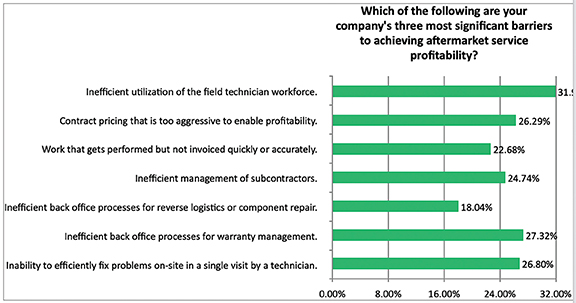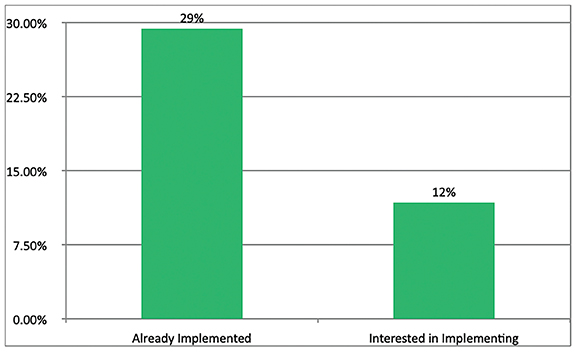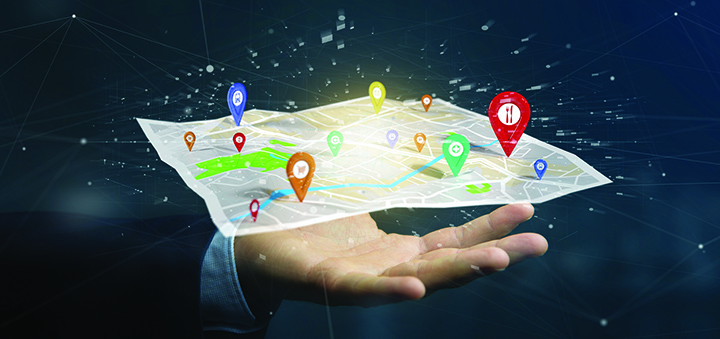Building a Better Reverse Logistics Engine
By Marne Martin, IFS
Brands care about their customers and companies care about growth. Customers can’t receive the experience they demand and companies can’t grow to their full potential without an understanding and focus on reverse logistics. What most companies don’t realize is that reverse logistics is vastly more complicated than forward logistics, and if you don’t have a best of breed solution for reverse logistics, you and your customers are suffering – and so are your profits. Returns can easily take 3-5% of your revenue, and with the rapid rise of e-commerce, that share is likely to continue to grow unless companies address their reverse logistics short-falls.
Standard parts management and logistics are a fairly well-tread territory for most organizations, e.g. parts and products come from an origin site and are delivered to a warehouse or client. This sort of activity is documented, optimized, and managed with ease by the modern enterprise. For many firms, though, when the need for parts, returns, and depot service arise, simply reversing that value chain seems like the place to start, and is quickly found not to be that simple. Firms are suddenly transformed from an intermediary to an end-to-end steward for customers’ needs; the transition is rarely seamless for customers, and your brand may suffer as a result. There are graveyards of organizations who have struggled with mapping and managing these processes in the past, but new reverse logistics technologies, stronger data analytics, and a thoughtful understanding of your business are making these processes increasingly manageable.
What defines reverse logistics maturity is not the same today as it was five years ago, as competitive pressure and customer expectations are greater than ever before. Sales volumes might be harder to forecast due to channel complexity, and understanding what is a return versus what is reusable or can be refurbished is also critical. What companies need to avoid is the erosion of customer trust, product value, and their margins.
How, then, does your firm stack up when it comes to managing reverse logistics? Do you have all the tools you need to maximize efficiency, save money, and decrease downtime for customers?
To answer those questions, we need to understand what the scope, and expectations, of successful reverse logistics look like today.
The State of Reverse Logistics
IFS has conducted several research studies in which we’ve reviewed, broadly, what reverse logistics looks like today. Before we delve into that, let’s take a look at how organizations perceive the impact of Reverse Logistics on their business.

Figure 1: The Impact of Reverse Logistics on the Bottom Line
Figure 1 gives us an idea of what is currently preventing or cutting into profitability at service firms of all sizes. For starters, reverse logistics software, specifically, was cited by about 1/5 of respondents. This may seem slight, but the complexity of Reverse Logistics means that even if you’re not specifically considering it, the impacts of poor performance ripple across the business.
To that end, while many did not cite reverse logistics specifically, a solid reverse logistics strategy will no doubt improve outcomes for many of these other categories; it is often overlooked as a cause of profitability decline and revenue leakage. Good reverse logistics software means that some or all of the following would happen:
- Better warranty management
- Faster, more automated invoicing
- Better routing
- Better contract management
- Better handling of returns, including what is re-usable or can be refurbished
With those demonstrative effects in mind, it’s clearly imperative for service organizations to have a robust reverse logistics plan in place. Naturally, this requires thoughtful investment in software to support those efforts. Figure 2 shows what share of firms currently have Reverse Logistics-specific software in place today.

Figure 2: Reverse Logistics Software Adoption is Maturing
The best way to understand the complexities that exist within your organizations’ shipping and logistics processes is through smart software investment, and truly, investment in that software makes a difference. Research from Aberdeen has shown that the top 20% performing service firms are twice as likely to have reverse logistics in place than the bottom 80%. The best performing know that reverse logistics software pays for itself. This, invariably, means that reverse logistics excellence is derived directly from specialized software, like IFS’s, functioning as the brain of your depot process engine.
The key, important, and consistent refrain that you’ll hear from those of us who study service, though, will always be that software alone will not solve your problems. Software is a tool, like any other, and the tool will only function properly if used within a solid infrastructure. How do you build that infrastructure?
Laying the Groundwork for Reverse Logistics Excellence
Foundational success with reverse logistics comes from, like all things, a functional understanding of the day-to-day operations of your business. From there, some external considerations need to run parallel to deployment of reverse logistics software, and most importantly, is the actual software solution that you will employ. We’ll simplify this a bit with some bullet points.:
- Map Your Unique Reverse Logistics Sequence
- Understand that Connectivity Extends Beyond Serviceable Assets
- Find the Right Software Partner
Where, then, should you start? Let’s start to unpack these three pieces.

Map Your Unique Reverse Logistics Sequence
I’m pleased to say that many organizations have a good handle on the totality of their reverse logistics sequence, but for many, the complexity of their business and serviceable materials mean that this knowledge is handled across tens of departments; unless technology is used, that information is in silos and leads to inefficiencies. Returns, depot repairs, part swaps, and so on, need to be coded in the same language, and managed with the same system. Mapping the various tracks through which parts and assets move from a customer through business systems is key. It’s imperative to your organizations’ operational success that all reverse logistics activities be handled in a unified, standardized fashion – which also is critical to meeting any goals or objectives related to sustainability.
Here is a questionnaire, with some light explanations, that can help you build a profile for your business:
What is the nature of your business?
a. Manufacturer of serviceable assets
b. Seller and servicer of assets
c. Service provider
d. Other
If this first question isn’t an easy one for your company to answer, then your business may have some bigger problems. This information is key, though, as it helps define the trajectory of how inventory passes through your system. The next question is for those firms that do not manufacture their own products:
Where do items go when they leave the customer?
a. Back to the manufacturer (for return or repair)
b. To specialized repair shops outside of our jurisdiction
c. To a central depot managed internally
d. To satellite locations managed internally
e. To local retail operations managed internally
f. Other
This helps you to build both ends of your logistical map. Where are items going to? There can, of course, be multiple answers for this question. Perhaps returns go to the manufacturer, part replacements go to an internal depot, and repairs go to third-party repair shops. Now that we have our map, though, we need to understand how inventory travels across it.
How do items get to their destination?
a. Customer shipping
b. Business shipping
c. Technician courier
d. Delivered by contracted technicians
e. Other
This is another instance where a combination of methods is not unusual. This, of course, is another key element in getting the big picture of reverse logistics for your company. Finally, and most importantly:
What sorts of items pass through your reverse logistics systems?
a. Full assets in need of repair
b. Full assets to be returned
c. Parts in need of repair
d. Parts to be returned
With all these things in mind, you can know with certainty that you have the full picture. One last consideration is whether the previously mentioned pieces are managed by warranties or not. We’ll get to that, though. Now that we have our map, we can start to add some points of interest. This brings us to our next section.
Understand that Connectivity Extends Beyond Serviceable Assets
When organizations think about IoT related to connected assets, equipment or devices, that conversation usually begins and ends with the serviceable assets themselves; IoT can be an equally powerful tool for parts management, and, by extension, reverse logistics. Tracking your parts and asset inventory from location to location as it is repaired is a key component of proper service. Making real-time location information available to the customer as well as the firm means that there’s a clear understanding of downtime.
Depending on how things move from place-to-place, perhaps some of this tracking will be managed by a fulfillment partner, but you still risk too much revenue leakage if you don’t have an internal system that tracks it all and measures performance.
There are several areas where IoT can support reverse logistics in one way or another. For example—a service provider that I’ve worked with has a service level agreement that states that their assets will never be down for more than ninety minutes. This means that from ticket generation through closing, a job must be completed in the same amount of time it takes some other companies to schedule a repair. This usually means a direct swap-out, but what if the depot is out of the appropriate asset? IoT systems employed across the organization may show that a truck’s inventory includes a refurbished asset of the same type in a technician’s truck, or freshly repaired at a local shop. This could save money, improve customer satisfaction, and avoid SLA penalties.
Now that we’ve talked about the map, and some of the infrastructure pieces, let’s discuss the piece that ties them all together.

The Right Software Partner
It’s easy for organizations to think about reverse logistics as parts management in reverse, and because of that, many firms settle on a boilerplate parts management solution and expect it to manage the dense cloud of inventory challenges that reverse logistics represents. Reverse logistics is much more than returns, though. For most service firms, it’s removing an asset or part from a customer, the act of repair or replacement, and getting that part back. It’s a microcosm of service in and of itself.
To add a layer of challenge on top of that, our journey mapping earlier should have made it clear that the systems, pathways, and outcomes for each firm will represent a layer of complexity that will be unique to your business. Furthermore, all of these pieces need to communicate with your inventory system, your field service management system, and so on, in order to maintain operational integrity.
With all that in mind, here is a brief buyer’s guide for reverse logistics software.
To become a reverse logistics expert…
Find a solution:
With dedicated reverse logistics capabilities. Parts management is great, but in order to manage reverse logistics from end-to-end, you want a solution that goes beyond parts management, and doesn’t just treat depot repairs as a reworked on-site repair. You shouldn’t have to change your internal processes to fit into your technology mold - your technology should accommodate you. The easiest way to do that is to start with a solution that’s actually designed to do, specifically, what you need it to do.
That organizes your firm’s complexity. After mapping out your reverse logistics pathways, it can seem daunting to consolidate those loose ends into a unified concept, which is why it’s so imperative to find a solution that does. Don’t compromise on how you want to see the stages of reverse logistics in action. Make it a requirement that the software provider(s) must understand service, and know how to best optimize your systems. Complexity is a good thing, as long as you’re capable enough to manage it. The right software will make you that capable.
That integrates seamlessly. As we have talked about previously, systems need to communicate in a common language. It may seem like a sophisticated reverse logistics engine with the depth needed for complex operations can only exist as a bolt-on, but the best service firms, like IFS, have not only the depth to handle any service need, but also the breadth of capabilities to ensure that every piece of the service lifecycle is centralized. Once service is managed, those systems naturally have to communicate with CRM, marketing, and so on. Don’t skimp on connectivity. Getting the full picture pays dividends.
Where the team will stay with you through the go-live, and remain a long-term advocate for your success. Software is software, and a good software partner will hook everything up where it needs to go and help you pilot your new software. The best integration partners understand your business, understand service, and remain an advocate and ally for your service success. This should never be a throwaway element of your reverse logistics plan.
Reverse logistics is having its moment, and now is the time to be sure that you’re ready to take full advantage of the capabilities available. If you map out your business needs, make the right hardware and software choices, and keep your eye towards emerging technologies, you can turn a complex process into an asset for your business.
 Marne Martin
Marne MartinMarne Martin as both President of IFS Service Management and CEO of Astea, Marne’s focus is to continue to elevate the importance of service management to the success of the overall IFS business. Marne works strategically to ensure the entire portfolio of IFS’s service management solutions provides customers with the business value they expect from a global industry leader in field service management (FSM). Prior to IFS, Marne served as CEO of WorkWave as well as CEO of ServicePower Plc. When not working, Marne enjoys competing in dressage and supporting girls and women pursuing STEM careers.